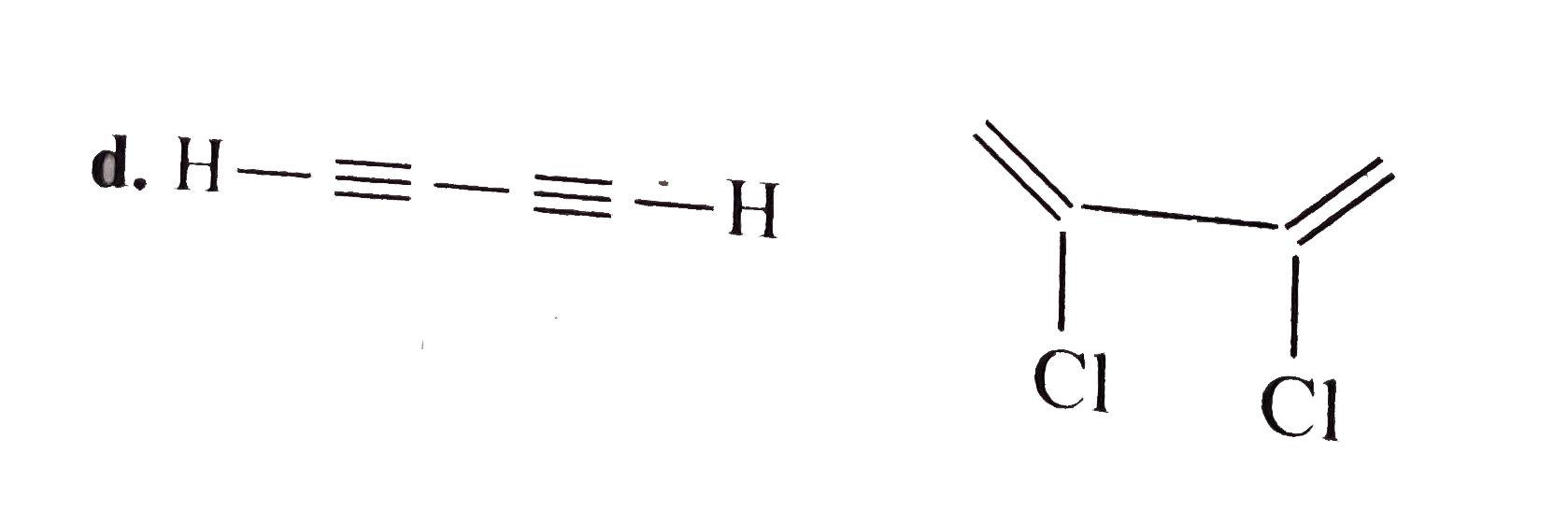Compounds (A) and (B) are:




The correct Answer is:A
To solve the question, we will analyze the reactions step by step.
Step 1: Identify the starting materials
We start with two moles of acetylene (C2H2), which has the structure H-C≡C-H.
Step 2: Reaction with CH2Cl2 and NH4Cl
When acetylene reacts with CH2Cl2 (dichloromethane) in the presence of NH4Cl, it undergoes a reaction to form vinyl acetylene. The reaction can be represented as follows:
2C2H2+CH2Cl2+NH4Cl→A (Vinyl Acetylene)
The structure of vinyl acetylene is H2C=CH-C≡C-H, which has a double bond between the first two carbon atoms and a triple bond between the last two carbon atoms.
Step 3: Formation of Compound A
Thus, compound A is vinyl acetylene (H2C=CH-C≡C-H).
Step 4: Reaction of Compound A with HCl
Next, compound A (vinyl acetylene) reacts with one mole of HCl. This reaction is an electrophilic addition where HCl adds across the double bond of vinyl acetylene. The reaction can be represented as follows:
A (Vinyl Acetylene)+HCl→B (Conjugated Diene)
Step 5: Formation of Compound B
The addition of HCl leads to the formation of a stable conjugated diene. The structure of compound B will be H2C=CH-CH=CH2 (butadiene).
Summary of Compounds
- Compound A: Vinyl Acetylene (H2C=CH-C≡C-H)
- Compound B: Butadiene (H2C=CH-CH=CH2)
Final Answer
Thus, the compounds A and B are:
- A: Vinyl Acetylene
- B: Butadiene
---
We start with two moles of acetylene (C2H2), which has the structure H-C≡C-H.
When acetylene reacts with CH2Cl2 (dichloromethane) in the presence of NH4Cl, it undergoes a reaction to form vinyl acetylene. The reaction can be represented as follows:
Thus, compound A is vinyl acetylene (H2C=CH-C≡C-H).
Next, compound A (vinyl acetylene) reacts with one mole of HCl. This reaction is an electrophilic addition where HCl adds across the double bond of vinyl acetylene. The reaction can be represented as follows:
The addition of HCl leads to the formation of a stable conjugated diene. The structure of compound B will be H2C=CH-CH=CH2 (butadiene).
- Compound A: Vinyl Acetylene (H2C=CH-C≡C-H)
- Compound B: Butadiene (H2C=CH-CH=CH2)
Thus, the compounds A and B are:
- A: Vinyl Acetylene
- B: Butadiene
Topper's Solved these Questions
- BOOK - CENGAGE CHEMISTRY ENGLISHCHAPTER - ALKYNESEXERCISE - Exercises (Archives - Single Correct Answer Type)6videos
ALKYNES
- BOOK - CENGAGE CHEMISTRY ENGLISHCHAPTER - ALKYNESEXERCISE - Exercises (Archives - Fill in the Blanks Type)3videos
ALKYNES
- BOOK - CENGAGE CHEMISTRY ENGLISHCHAPTER - ALKYNESEXERCISE - Exercises (Multiple Correct Answers Type)25videos
ALKYNES
- BOOK - CENGAGE CHEMISTRY ENGLISHCHAPTER - ALKENES AND ALKADIENESEXERCISE - Single correct Answer14videos
ALKENES AND ALKADIENES
- BOOK - CENGAGE CHEMISTRY ENGLISHCHAPTER - APPENDIX - INORGANIC VOLUME 1EXERCISE - chapter-7 Single correct answer1videos
APPENDIX - INORGANIC VOLUME 1
Similar Questions
Knowledge Check
- Question 1 - Select One
Succinic acid Δ−−→(A)NH2−−→Δ(B)Br2−−→KOH(C),Product (C) will be :
ACH2−CO2H∣CH2−CH2−NH2BCH2−CO2H∣CH2−NH2CCH2−CO−2K+∣CH2−NH2DCH2−CO2H∣CH2−CH2−Br
CH3CH2COOHCl2/Fe−−−−→(X)Alc.−−→KOH(Y)
Compound (Y) is :View SolutionCompound (A)1molof−−−−−−→HIO4

The compound (A) is:View SolutionCH≡CHNH4Cl−−−→Cu2Cl2 product
product is:View Solution(CH3)2CHIKOH−−−→EtOHASO2Cl2−−−→475KB
The compound B in the sequence isView SolutionIn the following sequence of reactions, the products (A) to (G) are formed:
i. 2CH4(g)Δ−−−→1773K(A)(g)+B(g)
ii. 4molof(A)Δ−−−−−−−−−−→Ni(CN)4+THF(C)O3/oxid.−−−−−→(D)only
iii. (A)(1)1molofNaNH2−−−−−−−−−−−→(2)C2H5I(E)3molofE−−−−−−→RedhottubeF⏐↓O3/Red.(G)only
Compounds (A) and (B), respectively, are:View SolutionF3C−CH=CH2HBr−−→(A)Nal−−−−−−−−−→dry.acetone(B)
View SolutionIn the following, identify the compounds/reaction conditions represented by the alphabets (A),(B), and (C).
H3C−CH=CH−CHONaBH4−−−−→(A)HCl−−→ZnCl(B)KCN−−→H+(C).View Solution

